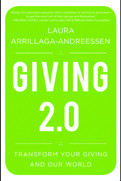
Giving 2.0: Transform Your Giving and Our World
Laura Arrillaga-Andreessen
320 pages, Jossey-Bass, 2011
Like many of her fellow students in the Stanford Graduate School of Business class of 1995, Laura Arrillaga-Andreessen felt a “burning desire” to be an entrepreneur. But while they parlayed their lessons in finance and management into dot-com business plans, she envisioned a venture of another stripe, one that would harness Silicon Valley’s newest wave of entrepreneurial energy and wealth for community benefit. “I wanted to do something different,” she writes. “Instead of establishing an organization to make money, I wanted to create one to give it away.” Three years later, she launched the Silicon Valley Social Venture Fund. Today, SV2 is thriving: successfully wooing, engaging, and educating generations of Silicon Valley talent, who are great at being go-getters, to become givers.
Founding SV2 marked the end of Arrillaga-Andreessen’s apprenticeship in philanthropy and launched her on the quest that inspired and informed Giving 2.0. Over the succeeding 15-plus years, the author immersed herself in the field: creating and teaching graduate business and undergraduate courses at Stanford University, commissioning case studies, serving on nonprofit boards, helping design Stanford’s Center on Philanthropy and Civil Society, interviewing hundreds of fellow travelers, and learning by giving herself. She has consistently upped the ante for her own philanthropy with every new lesson learned.
From her parents, especially her beloved mother, she absorbed what it meant to leverage personal gifts of heart, mind, and time to make truly meaningful contributions. Creating an organization, however, signaled a whole new level of commitment and propelled Arrillaga-Andreessen on to the next phase of her journey in philanthropy, one that confirmed she’d found her career and her calling.
Giving 2.0 is the result of Arrillaga-Andreessen’s intellectual and experiential odyssey. From ancient practices like tithing to today’s peer-to-peer giving platforms, she shows how philanthropy has evolved. With each chapter, we are introduced to a particular form of giving. The book begins with volunteering. We meet Hector Chau, a good-humored and accomplished Mexican American, now retired from his accounting career and volunteering for Tax-Aide in Los Angeles, which provides older low- and middle-income Americans with free, professional tax return service. Arrillaga-Andreessen celebrates him as an exemplar of effective philanthropy, as she does a diverse, engaging cast of characters from all walks of life and backgrounds. Like Chau, they’ve all discovered personal assets to off er their communities, a cause, the world—and set about “transforming their giving,” as Arrillaga-Andreessen writes, to great benefit.
Throughout, the author cites research that informs and validates philanthropic practice. For the chapter on volunteering, she references Stephen Post, a bioethicist at Brown University’s Alpert Medical School, whose work proves the value of the “prosocial” engagement expressed through voluntarism. Arrillaga-Andreessen displays knowledge of the field that is Wikipedia-like in its comprehensiveness and currency. She weaves together reams of facts and statistics, references to historical influences, descriptions of organizations and their approaches with an easy, graceful narrative style. In the opening chapter, she grounds us in French philosopher Alexis de Tocqueville’s 19th-century travels through the young American republic, citing his observation of the natives’ collective go at improving their communities. She then brings us current, noting that some 63 million of Americans volunteer today, and goes on to describe the roles played by a wide range of organizations operating in the space: stalwarts like the Rotary Club and Junior League, government-backed entities like Senior Corps, established innovators like Civic Ventures and the web-based VolunteerMatch, and recent startups like Crowdrise and Catchafire.
Hewing to this structure, chapters cover myriad ways of giving, and each one is followed by a “Making It Happen” section designed to help readers probe their personal motivations and apply insights to themselves, their families, and their lives. The book’s appendices provide a wealth of resources, including a guide to keeping a giving journal and a bibliography.
Giving 2.0 speaks directly to the influence of millions of ordinary people whose contributions form the backbone of American philanthropy, adding up to more than $200 billion and 8.1 billion hours of volunteering each year. A compelling, meticulously researched work, Giving 2.0 pays its readers the ultimate tribute by assuming that they have what it takes to become powerful givers themselves. Its influence will be felt in untold acts of more informed and thoughtful giving. And its—and Arrillaga-Andreessen’s—impact will be registered in the societal transformation those vastly better gifts make possible.
If you want to understand the history and future of giving, this is the one book you should read. Make a gift of it.

